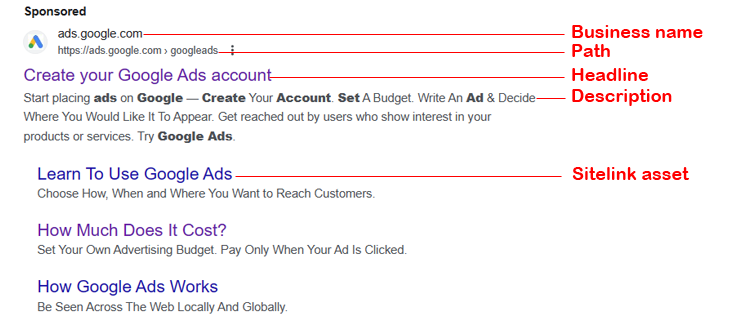Writing Effective Google Ads Text Ads – The Right Ingredients to Increase Engagement

Writing effective text ads is a vital step in Google Ads campaign creation. No matter what your advertising goal is, when you are running a Google Ads campaign, your ads are your first chance (and sometimes your last chance) to impress and attract a prospective customer.
You should create your ads based on your campaign goals and continuously test new ads to find better performing ads. Every successful Google Ads campaign will have a good ad testing and optimization strategy.
Text ads are the simplest ad version in Google Ads. Google now only allows responsive search ads as part of their broader drive towards using artificial intelligence and machine learning in campaign optimization.
A responsive text ad can have a maximum 15 headlines, 4 lines of description text and 2 paths (paths are used to enhance your display URL).
The Basic Rules of Writing Effective Google Ads Text Ads
Effective text ad writing starts with your ad group creation. When you organize your campaign, always create tightly themed ad groups. This will help you to write very specific ad copies as per the keywords in your ad groups.
There are strict character length limits applicable to the parts of a text ad.
Headlines (15 in total – minimum 3 is required in an ad) – 30 Characters each
Description lines (4 in total – minimum 2 is required in an ad) – 90 Characters each
Display URL Path (2) – 15 Characters each.
An example text ad with different elements of the ad,

Google Ads Text Ads – Editorial and Professional Requirements
Your ads should follow high professional and editorial standards in order to provide quality user experience. Some of these requirements are,
- The ad message must be clear and consistent with informational presentation style.
- The ads must be within the allowed character limit.
- The spelling and grammar should be correct, and excessive punctuation or capitalization is not allowed. Always check the spelling before uploading your ads.
- Do not use invalid or unsupported characters like an emoji.
- Non standard repetition of words or unacceptable spacing is not allowed.
- Do not include phone number in text ads.
- Do not use exclamation marks in headline. Do not use a very generic call to action such as ‘click here’
- Do not use brand names or trademark terms in your ad text if you are not authorized by the brand owner to use them.
- Superlative or comparative claims must be supported by third-party verification on the landing page.
- The website or landing page should be easy to navigate and it should load quickly.
You can find the official editorial guide here.
Ingredients of a Good Text Ad
- Clearly explain about the product or service that you are promoting.
- Explain the features and benefits of your product or service.
- Include prices, offers and discounts.
- Tell your customer what makes you unique.
- Encourage customers to take action – Include a call to action
- Write specific ad copies as per the keywords in your ad group – Include keywords in ads.
- And the most important part – link your ad to the most specific landing page, which has the products or services, and offers that is mentioned in the ad.
Writing Ads that Standout from the Rest
One of the many things that influence your click through rate (CTR) is your ad position. Having a higher ad position is good to grab instant customer attention. But when you are accompanied by similar ads in the search results, just having a higher ad position is not enough to get the clicks and customers.
Your ad must stand out from rest of the competitor ads if you want to get more attention from your prospective customers.
Some of the suggestions below will help to create ads that get more attention from the rest.
- Use numbers in you ads. Include prices and discounts. Using numbers will also help you to save space for more text.
- Use symbols, another easy way to grab user attention – Use registered and trademark symbols (™, ®). Use currency symbols with price ($, £, €). You can also use other appropriate symbols in your ads (%, &).
- Writing Text Ads? – Yes, test using questions in your ads. It is another easy way to stand out from the rest and generate curiosity in your customer’s mind.
Check the text ads below, which use symbols and question marks very effectively,

- Tell the user what they need to do next. Include strong call to action in your ads like – Call Us, Shop Now, Get a Quote, Book Now.
- Use power words like Expert, Specialist, Guarantee, Authentic, or official.
- Use all appropriate ad assets (extensions) & customize your display URL paths to get more attention from customers. Using ad assets will also help you to get better CTR, helping you to improve your quality score and reduce your cost per click.
Ad Testing Opportunities
You should continuously test new ads to find more profitable ads. Test every element in your text ads. Test different titles, description lines, offers, call to action or display URL paths.
The testing opportunities are endless. Creating ad variations for testing is not too difficult. At times you can easily create ad variations by telling the same story in different ways.
Consider you are going to sell a $10 product for $5 for a limited period. You can present this offer in many different ways in your ads.
| Save $5 | $5 Off | $5 Discount | Only $5 |
| 50% Discount | 50% Off | Save 50% | Half Price Sale |
All these claims tells the same story, but in different ways. And until you test all these variations you will not find the one which is more appealing to your customers.
And if you can combine an offer like this with a message which creates urgency like “Offer Ending Soon” or “Limited Time Offer” it can produce some great results.
Ad Testing in the Age of Responsive Search Ads and Automation
The current responsive search ads in Google Ads will not allow you to test your ads properly. That is the truth. In every responsive search ad, you can add up to 15 headlines and 4 descriptions. The Google Ads system will then mix and match these parts (called assets now) in to multiple ad combinations.
The ad will be served in a way the system deemed fit, not in a way an advertiser wants to use it. Often the priority will be given to ads which generates the most click through rate (CTR). But many times, ads with the highest CTR will be the ones with the lowest conversion rates.
The worst part is, the current reporting in Google Ads will not share the conversion data associated with any of the ad combinations that is shown to your customers. This makes it impossible to measure effectiveness of your ads.
The only way to tackle this is by testing ads with only the necessary assets, 3 Headlines and 2 description lines and position pinning each asset in specific positions as you want it to appear in the ads.
Consider these When You Test Ads
- Enable conversion tracking in your campaign. Without accurately measuring the results (conversion/sale/lead) it is impossible to optimize your ads.
- When starting, use more than 1 ad in your ad group with different messages (3 different ads will be good).
- Use ‘Do not optimize: Rotate ads indefinitely’ setting when you test ads (Settings > Advanced Settings > Ad rotation). This setting will give equal opportunity to all the ads in a test. If you use ‘Optimize: Prefer best performing ads’, the system will decide which ad will be showed and the percentage served. This can influence the outcome of a test.
- Use labels to mark the ads in a new test. This will make result analysis easy.
- When you analyse data after a test, always select the correct date range. Keep in mind when you started the test. Analyse data for a time period when all the ads were running at the same time.
- Always consider your campaign marketing goal when you analyse the data after a test. For example, just an increase in CTR will not be good enough to declare a new ad a winner, if conversion (lead, sale, sign-up) is your campaign goal.
- Always try to test only one element in an ad. If you test multiple elements in a single ad, it will be difficult to determine which new element in the ad is responsible for the change in performance.
Hope these suggestions will help you to write effective text ads for your Google Ads campaigns and efficiently test your ads to increase profits and grow your business.
Need help? Please don’t hesitate to Contact Us.
